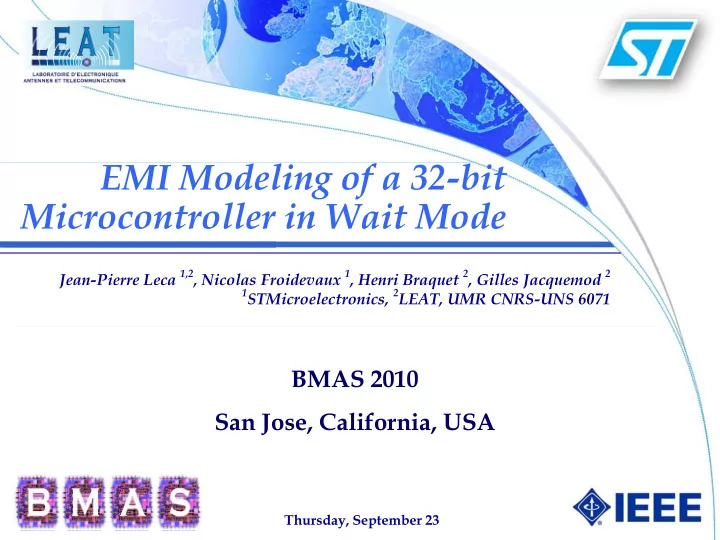

EMI Modeling of a 32-bit Microcontroller in Wait Mode Jean-Pierre Leca 1,2 , Nicolas Froidevaux 1 , Henri Braquet 2 , Gilles Jacquemod 2 1 STMicroelectronics, 2 LEAT, UMR CNRS-UNS 6071 BMAS 2010 San Jose, California, USA Thursday, September 23
Outline 1. Motivations 2. EMI Background 3. EMI Modeling 4. Results and correlation 5. Conclusion 2
1. Motivations EMI: Disturbances that affect an electrical circuit due to either EM conduction or EM radiation emitted from an external source. Why? EMI are generally increasing with the shrink of CMOS technology & the rise of products’ performances. Products must be IEC 61967-2 or SAE J1752/3 compliant. Marketing argument (automotive, medical, GPS…). To save time, money, and gain market share. 3
1. Motivations How? Before we were expected, now we want to act. Define EMI strategy during the design stages by: Use of predictive EMI models. Layout/Design rules implementations during the product design flow. 4
2. Background Basic EMI mechanisms: Noise generation due to switching currents created by: Clock-driven blocks, synchronized digital core Accesses to the memories (Flash, RAMs, …), I/O switching activity AC currents converted into P/G voltage drops (common mode radiation): SSN for « Simultaneous Switching Noise » due mainly to the wires parasitic inductances EM Field Creation P/G current loops (differential mode radiation) EM Field Creation Unintentional EMI radiation by miniature antennas (lead frames, interconnections…) Intentional or unintentional receivers can then pick up these EM waves
2. Background EMI measurements: Based on IEC 61967-2 standard: Dedicated EMI printed circuit board Help of a TEM-Cell as an EMI receiver Results visible on a spectrum analyzer
2. Background Measurement results: 32-bit STXX running in Normal mode (f OSC =8MHz & f PLL =24MHz): SAE level of 5 (Not recommended in applications). Main CPU clock enabled and accesses to the FLASH memory. Resonance @ 660MHz.
2. Background Measurement results: 32-bit STXX running in WFI mode (f OSC =8MHz & f PLL =24MHz): SAE level of 4 (High EMI risk in applications). Main CPU clock and FLASH memory disabled. Resonance @ 660MHz.
3. EMI Modeling Modeling methodology: Based on the ICEM, for « Integrated Circuits Emission Model ». standard (IEC 62014-3). Goal: To predict EMI level during the design stages. To test different design/layout solutions.
3. EMI Modeling Microcontroller modeling: Main noise generators: FLASH memory. Normal Mode 1.8V Digital core. Crystal Oscillator, PLL, extracted clock tree. Wait Mode Digital Core model: PWL current source On-die admittance
3. EMI Modeling RedHawk-CPM Principle: On-chip P/G network => RLC mesh Switching instances => PWL sources i(t,V) after standard cells characterization Non-switching instance => decaps, ESR
3. EMI Modeling Apache-CPM flow: Needs: .tech, .lib, .cdl, .gds2, .def, .lef …
3. EMI Modeling Microcontroller WFI model: WFI mode: Memories and digital core disabled – Simulated Model . Best case for the EMI SAE level = 4 Modeling possible in SPICE. Three main parts: Die model (noise generator + on-die PDN). Package model (off-die PDN). TEM-Cell model (receiver PDN).
3. EMI Modeling Die model: Noise generator constituted by: Generator 8MHz crystal oscillator and 8 to 24MHz PLL. Noise 3.3V to 1.8V regulator. Internal capacitances between the supply rails (by estimation, post- layout extraction or simulation). On-die Power Distribution Network Wires inherent inductances and resistances. Tracking of the supply rails from the product gds2. Inductances and resistances computation (no skin-effect and mutual inductance in this model).
3. EMI Modeling Package Model: STXX 100-pin LQFP bonding diagram: Long bonding wires => important inductances. Need also to add the inductance due to the lead frames.
3. EMI Modeling Model obtained with Ansoft Q3D and HFSS: Each supply couple is modeled. Valid up to 1GHz. RLCK network.
3. EMI Modeling TEM-Cell Model: Obtained with an EM solver: Representation of the electric and magnetic coupling between the chip and the TEM-Cell septum Valid up to 1GHz RLCK network
3. EMI Modeling
4. Results and correlation Comments on the model: In this model: Only the voltage drops are modeled. The current loops are not modeled. SPICE simulation with ELDO: External 8MHz quartz (with its capacitances) PLL with a factor x3 PVT conditions: Typical process, VDD IO =3.3V & V CORE =1.8V, T°=27°C Good correlation with WFI measurement (see next figure) Similar amplitude peaks. EMI at the same frequencies (harmonics + resonances) Effect of the position of the chip visible.
4. Results and correlation
4. Results and correlation
4. Results and correlation Comments: Resonance frequency near 660MHz: Observable behavior in measurement and simulation. The SSN on supplies is a damp sine wave in the time domain. In the frequency domain, RLC filter effect due mainly to: The package inductance The capacitance between the supplies Effect of the on-die resistance (Q and BW) π f 1 L 2 f ∆ = = = f Q f c 0 π R Q c 2 LC Conclusion: an EMI level of 4 when the chip is running in a WFI mode could be predicted during the design stage.
5. Conclusion Performances : Good EMI prediction. Good EMI mechanisms representation. Quite simple to put in place. Limitations: Only apply to the WFI mode. Long simulation time (~15 hours). Future improvements: Add others running modes by modeling the digital core and the Flash memory.
Thank you for attention!
Recommend
More recommend